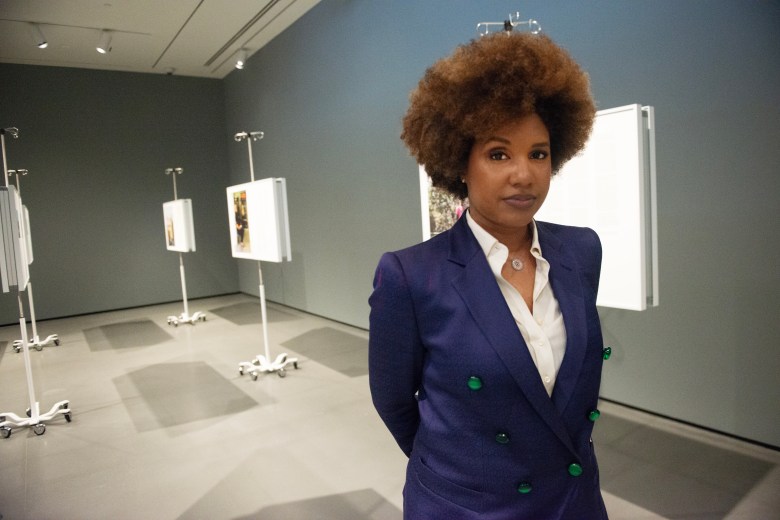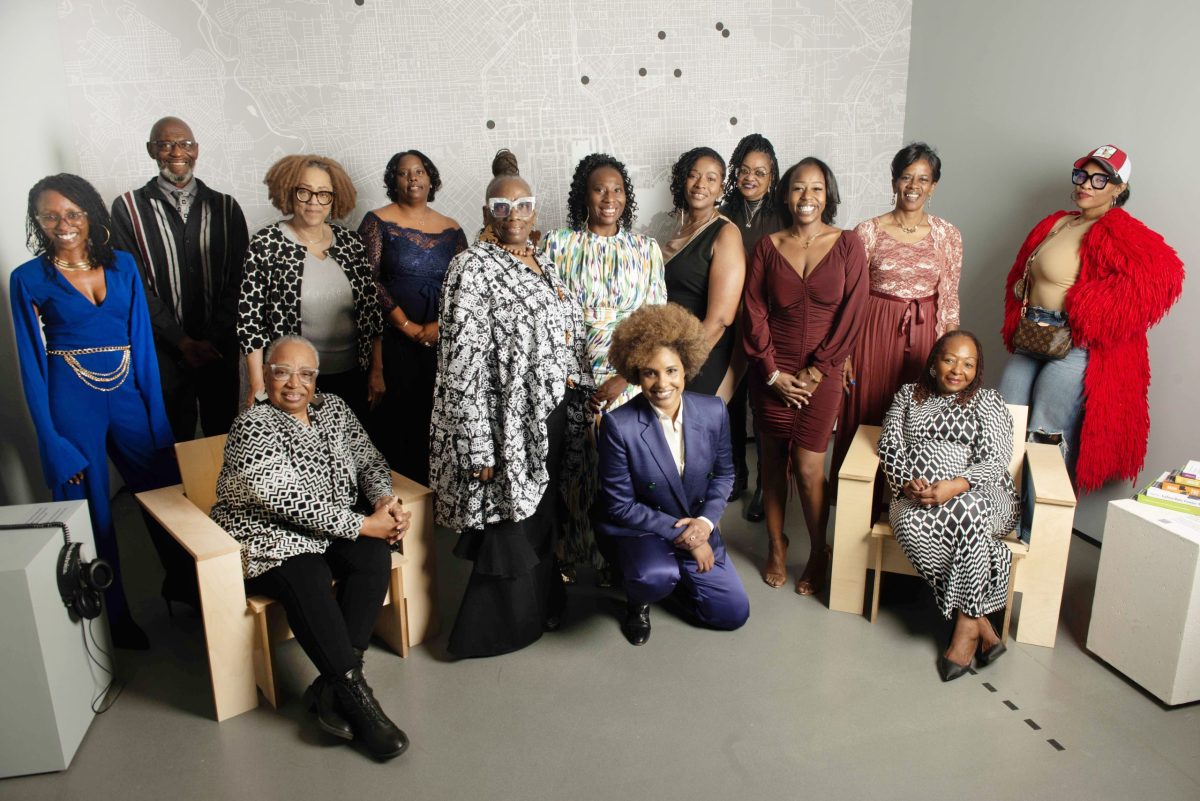“Are you sure, sweetheart, that you want to be well?…Just so’s you’re sure, sweetheart, and ready to be healed, cause wholeness is no trifling matter. A lot of weight when you’re well.”
– Toni Cade Bambara, The Salt Eaters
The journey to healing is intimate and vulnerable. Everyone has a testimony that explains the miracle of their lives, a praise song to the persistence of their sound body, spirit, and mind. Your testimony accounts for the ways you pushed forward when others told you to stop and the moment you finally left those naysayers behind. Your testimony celebrates those who encouraged you when you needed it most and the support you continue to provide for others in need. By the grace of God, beloved, you are still here, still standing, despite all odds. A witness to the wonder and the marvel of life. More than a conqueror.
“God meets you where you are,” wrote Ms. Veda Moore in a testimonial she contributed to LaToya Ruby Frazier’s latest masterpiece, “More Than Conquerors: A Monument for Community Health Workers of Baltimore, Maryland 2021-2022,” which is now on view at the Baltimore Museum of Art through March 23, 2025. Frazier, an accomplished photographer, educator, and activist, has dedicated her life to illuminating the humanity of Black working-class communities. Moore’s portrait is triumphant — she stands regally in the center of a tree-lined path, ova east at North Milton Avenue and East Eager Street. Head to the sky, the sun reflects her radiance. Ms. Moore’s testimonial is one of 18 stories from Baltimore-based community healthcare workers (CHWs) featured in the exhibition. Other contributors include La Kerry B. Dawson, Tracy Barnes-Malone, Karen Dunston, Kenya Ferguson, Griselda Funn, Erica Hamlett, Donnie Missouri, Kendra N. Lindsey, Evelyn Nicholson, Helen Owhonda, Gregory Rogers, Wilfredo Torriente and Latish Walker.
The exhibition was initially commissioned for the 58th Carnegie International and won the esteemed Carnegie Prize. In 2023, The Baltimore Museum of Art acquired the work for its permanent collection. Every portrait is a monument unto itself, mounted in socially-distanced rows on stainless-steel IV poles. Collectively, the work stands as a living commemoration of unsung heroes, essential workers who daily put their lives at risk to support the needs of others. Many of those workers are women. All of them are people of color. All are members of a vital army who operate in plain sight but are rarely recognized for their efforts. At the height of the COVID-19 pandemic, when a mandated sequester stalled the world, essential workers — particularly community healthcare workers — stood in the gap.
At the height of the COVID-19 pandemic, when a mandated sequester stalled the world, essential workers — particularly community healthcare workers — stood in the gap.
Frazier was made aware of the efforts of CHWs by reviewing the public health equity research developed by Dr. Lisa Cooper, Bloomberg Distinguished Professor at Johns Hopkins University School of Medicine and Director of the Johns Hopkins Center for Health Equity; Dr. Chidinma A. Ibe, assistant professor of medicine at Johns Hopkins University; and Dr. Anika L. Hines, assistant professor, Department of Health Policy at the School of Public Health at Virginia Commonwealth University. While on a panel discussion with Dr. Cooper, an audience member posed a query to Frazier about the developments that could occur in public health equity work when artists and doctors collaborate.
“The seed from this project was planted on that panel,” Frazier shared with me over Zoom. “It was the first time Dr. Cooper and I met, and she knew my work, ‘The Notion of Family (2001 – 2014),’ and my 14-year collaboration between my mother, grandmother, and me, and it represented for her a methodology that doctors, researchers, and scientists use called photovoice.”

Photovoice is a qualitative research process of inviting patients to use cameras to document their lived experiences in order to better share those experiences with doctors, who can utilize that data to support public health equity policy change. Frazier has a long history of using her camera as a tool for social advocacy on behalf of Black working-class communities in America. The urgency to assess healthcare inequities became especially central to Frazier’s practice when she became the victim of medical racism and was denied access to the COVID-19 vaccine. That instance concretized for Frazier that if she could experience that level of blatant disregard for her health, despite her success, while wearing business attire, then it was likely that many others were also unprotected and unsupported in times of medical crisis. She wondered who was providing those services when traditional facilities were not. She learned that it was CHWs.
“If Black people are afraid of being racially profiled at these sites, if we’re afraid of the law enforcement at these sites if we have disabilities or don’t have access to get to these sites, who is the person that is the liaison that helps us get access?” Frazier noted. “When I called Dr. Cooper and told her what they did to me, she understood that it was about implicit bias in the medical field, and she immediately put me in touch with her mentees to learn more about their work in Baltimore.”
Public health equity research clarifies the environmental factors that influence health disparities or barriers to health. To better understand the realities of community health care workers in Baltimore City, Dr. Cooper introduced Frazier to Tiffany Scott, co-founder and president of the Maryland Community Health Worker Association, who intimately understood CHWs’ needs.
“CHWs need as much support as we give to our communities,” Scott shared. “With most professions, once you finish your day or shift, you are no longer on duty. But as CHWs, we can’t turn that off. It’s a ministry.”
“CHWs need as much support as we give to our communities,” Scott shared. “With most professions, once you finish your day or shift, you are no longer on duty. But as CHWs, we can’t turn that off. It’s a ministry.”
Scott personally drove Frazier around the city so she could better understand the neighborhoods that the CHWs come from and continue to serve. Scott was an essential liaison between the CHWs and Frazier. I asked her why she felt the project was so important.
“I felt it was time for recognition,” Scott continued. “CHWs do a lot more than people will ever be able to recognize…I wanted the voices of the underdogs to be heard. Having the interviews with LaToya and the conversations one-on-one with CHWs was a healing process for us because we got to say what we were going through without judgment.”
Monuments are rarely dedicated to the living, and it is even more unusual for laborers, underdogs, and the working class to be honored. We are socialized to be apathetic to the experiences of everyday people rather than advocates for each other’s protection. This was made startlingly evident during the height of the COVID-19 pandemic when communities that were most vulnerable, uninsured, and low-income were also more likely to be on the front lines providing essential support. By working with community healthcare workers in Baltimore, Frazier understood how important monumentalizing their efforts would be not only for them but as a model for the entire nation.
By working with community healthcare workers in Baltimore, Frazier understood how important monumentalizing their efforts would be not only for them but as a model for the entire nation.
“They immediately started crying [when they saw the monument] because they said nobody had ever wanted to make a portrait of them, let alone pay attention to them at all,” Frazier continued. “They helped me understand that they are the foot soldiers of the healthcare system, but no one respects them or recognizes them. So [More Than Conquerors] was an affirmation and a confirmation for them that for me as an outsider to care and to show up with my creative resources to try to document this understanding was historic… This is an anti-monument,” Frazier elaborated. “It’s about the love that is enacted upon us in times of great sorrow that society chooses not to perceive — it’s about a monument of solidarity, a monument about agape love, the highest form of love — it’s important for humanity… all of us in the work are survivors. I strongly believe in democratizing the arts, I believe it should be accessible to all people.”

